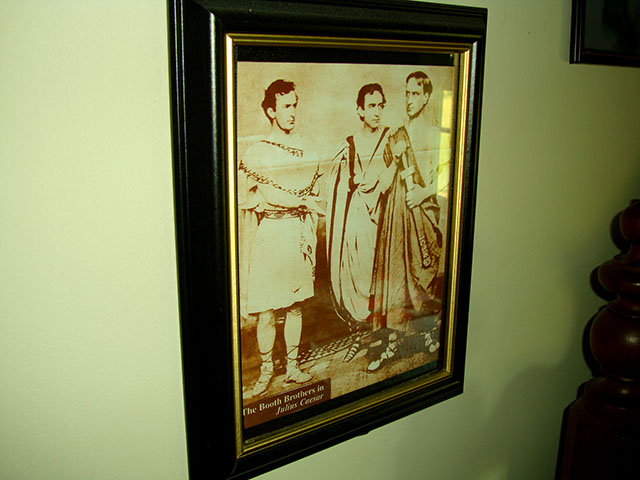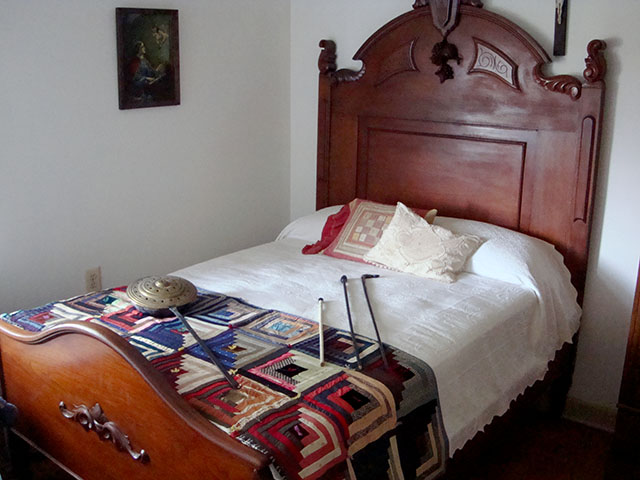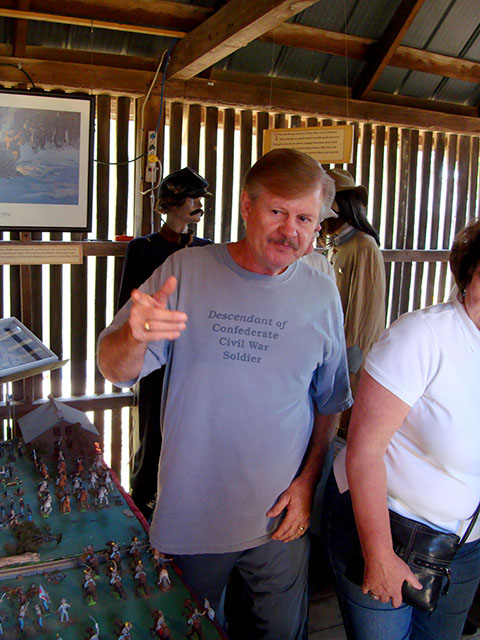Somehow John Wilkes Booth broke his leg shortly after he shot the President. The story I've always heard -- that he caught his spur in the bunting of the President's box at Ford's Theater and broke his leg as he fell awkwardly to the stage -- may not be exactly true. What is true is that somewhere, somehow that fateful night he suffered a simple fracture of the tibia and fibula, his leg began to swell, and he needed a doctor fast. And he knew just the place to go.
Dr. Samuel Mudd lived in this house near Bryantown, MD, about 25 miles south of DC. Mudd and Booth had known each other for some time; in fact, it seems very likely that if Mudd didn't have advance knowledge of the assassination plot, he did know of Booth's earlier plan to kidnap the President. At any rate, around 4:00 a.m. on the morning after the assassination, Booth and David Herold showed up at Mudd's door asking for assistance with Booth's leg.
This photo now hangs on the wall of the room in which Mudd cut off Booth's boot and set his leg. Depicted are brothers John Wilkes, Junius and Edwin Booth, three of the most famous actors on the 19th Century American stage. The only time they acted together professionally was in this production of Julius Caesar in New York. That's John Wilkes Booth in the short tunic.
Somebody said those riding sticks belonged to John Wilkes Booth. I'd like to see proof of that, but could be.... At any rate, Dr. Samuel Mudd did attend to John Wilkes Booth's injuries the morning after the assassination, April 15, 1865, and Booth and his companion David Herold did spend some of that day at the Mudd home. It's unclear whether Mudd learned about the assassination from Booth that morning, but by afternoon Mudd had been to town and he'd heard the news. It's also unclear whether upon his return home he told his visitors to leave or whether they left of their own accord. Now some say that Mudd provided assistance to Booth in all innocence, while others claim he was in on the plot from the beginning. What we do know is that Mudd delayed telling authorities that Booth had been to his home, was untruthful when questioned, was caught in his lies, and was sentenced to prison for his actions. He avoided hanging by only one vote, and was sent to a fetid Federal military prison -- Fort Jefferson in the Dry Tortugas, about 70 miles from Key West, Florida. Because of his heroic actions during a Yellow Fever epidemic at the prison, though, Dr. Mudd eventually received a pardon from President Andrew Johnson and returned home in 1869.
Here's a nice table in the entrance hall of the Mudd house.
The Mudd family dining room.
Dr. Mudd built that round card table in prison.
The doctor had a nice view of his farm from his back yard. That road is just as it was in the 19th Century.
The doctor had some fine transportation.
Patrick Rohan, our Smithsonian Associates coordinator, enjoys the view from an Adirondack chair.
More of the doctor's farmland.
Out-buildings on the farm.
We learned on this tour that anti-tobacco sentiment in the present day has caused a dramatic decrease in tobacco farming in Maryland and Virginia. These tobacco leaves are drying just for display.
Antique tobacco products.
Now one of the out-buildings was very interesting.
Inside we found this guy, a Civil War buff extraordinaire.
Why he even got to be an extra in Ted Turner's Civil War epic, GETTYSBURG. See that soldier between the two Confederate flags, the one staring straight at the camera? That's our guy. Sure wish I'd caught his name.
He was so excited to have a big group of interested tourists to talk to. He showed off his recreation of a Civil War encampment.
He showed off his collection of Civil War soldiers.
He even showed us one of his proudest possessions, a bullet which he found at the Gettysburg battlefield, near the site of a field hospital. Just look at that thing. Have you ever heard the term, "bite the bullet?" Well that's what they told patients to do when they were going to have to hack off a leg and there was no anesthesia. Now look at the bullet again -- see the mark of a molar?
Don't believe me? Well, look at the other side. See? Told you.
There's the tent up close.
Hey look...somebody's in there. That's some beard you got there fella.
More soldiers.
Another view of Dr. Mudd's house.
And here's a view of Dr. Mudd's original tombstone. He's not buried here, though. He's buried in town at the Catholic Church.
Nice chairs, don't you think, Benecia?
A cozy table in the kitchen.
The finest in 19th Century farm house dinnerware.
I could live in a place like this.
Now Patrick has found some company.
The place looks much as it did in Dr. Mudd's day.
This is where Samuel Mudd is actually buried -- in the St. Mary's churchyard. The old headstone was removed and replaced with this when Mrs. Mudd died in 1911. So...a Confederate flag, hm? Guess we know whose side he was on. |
































